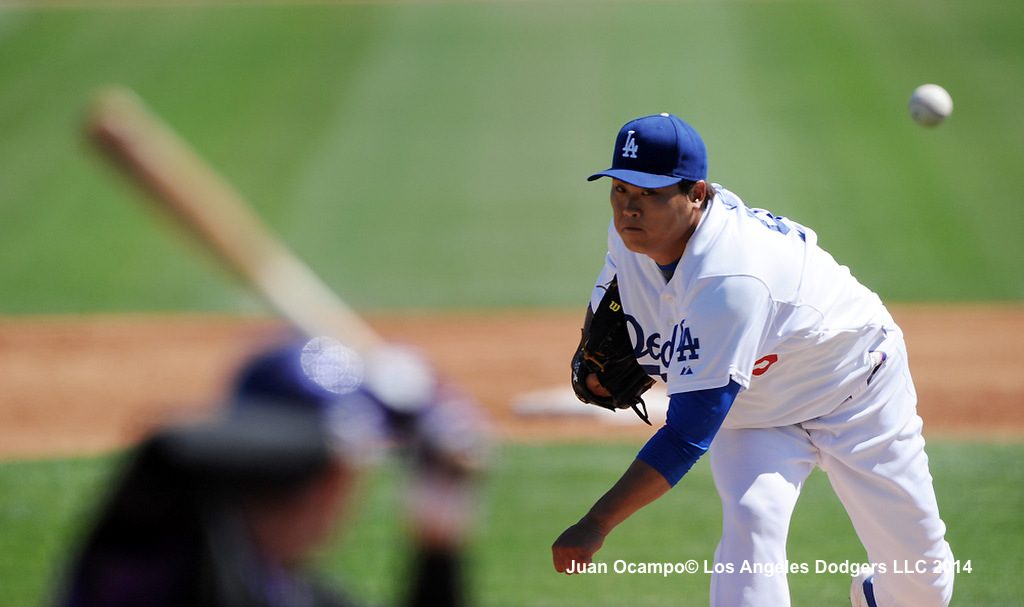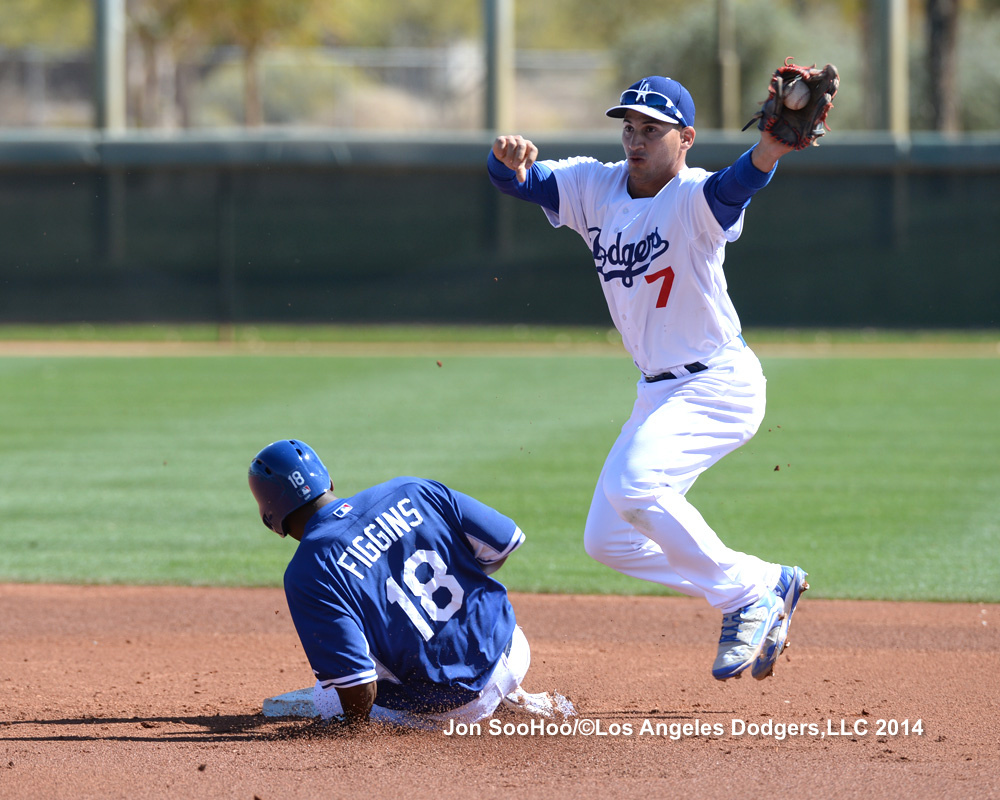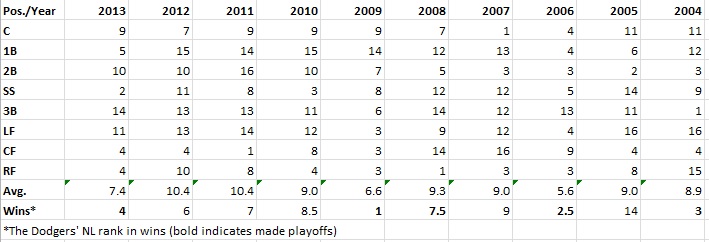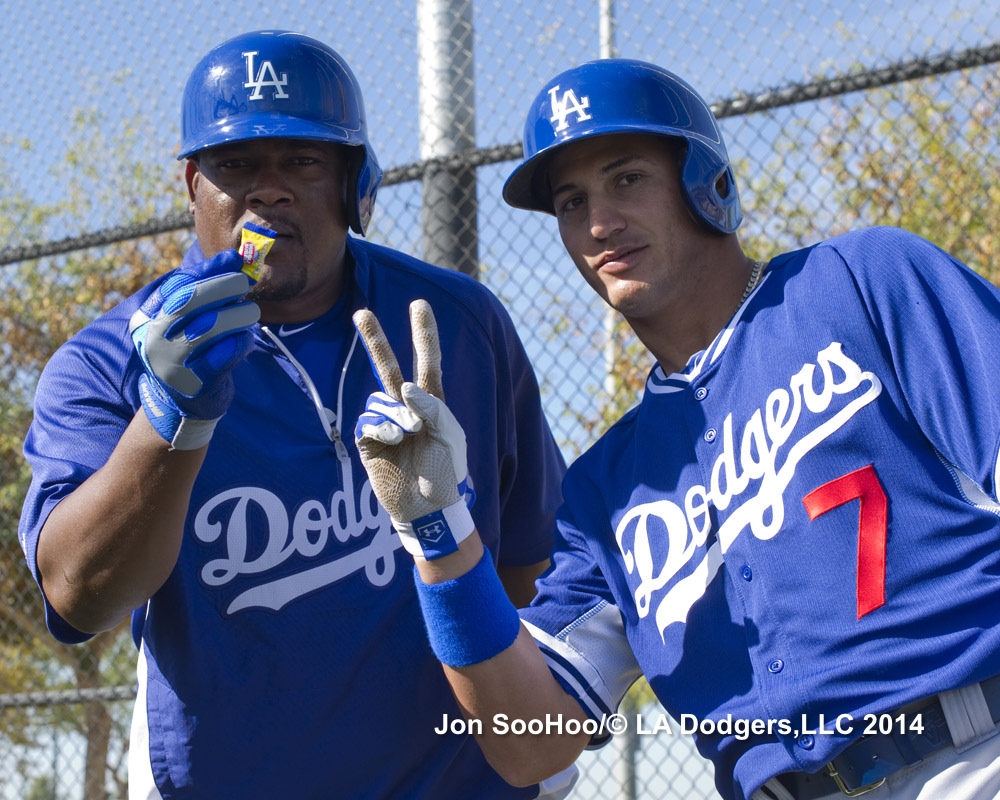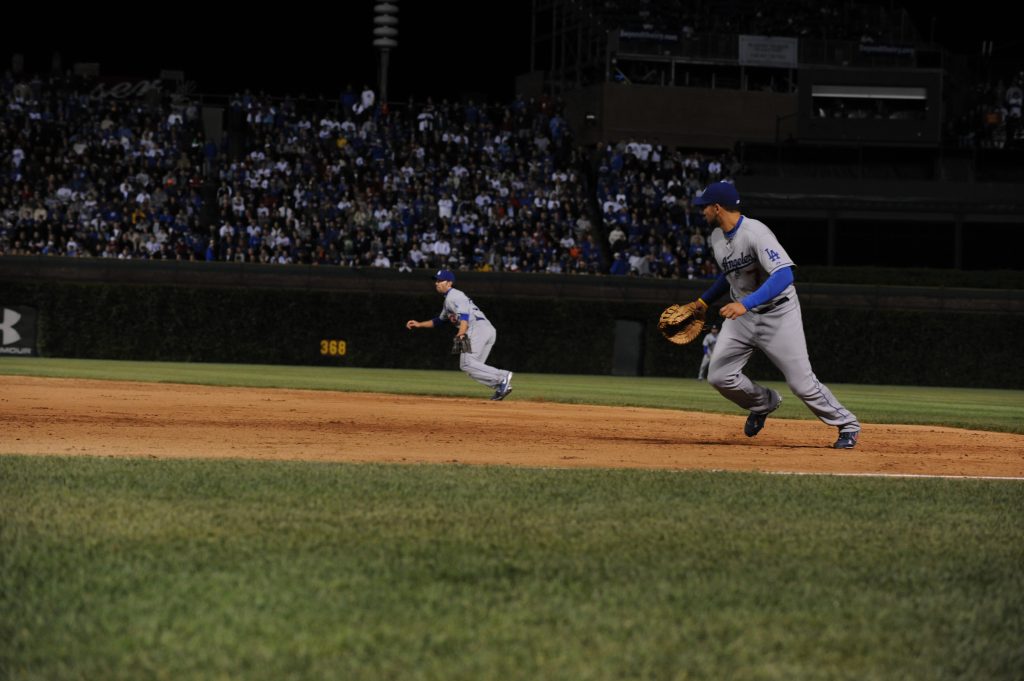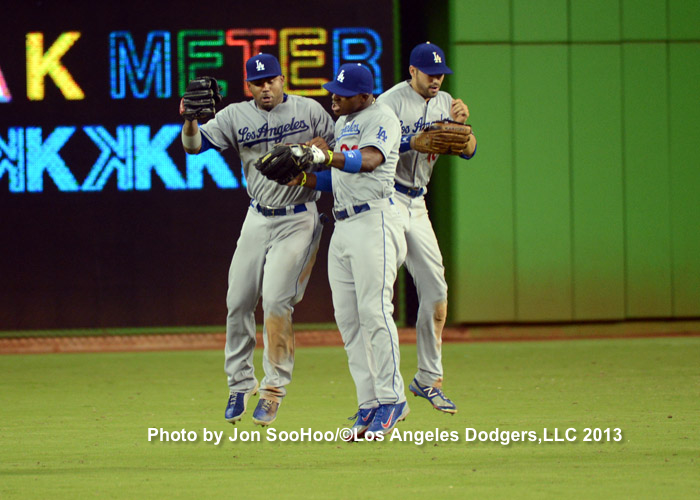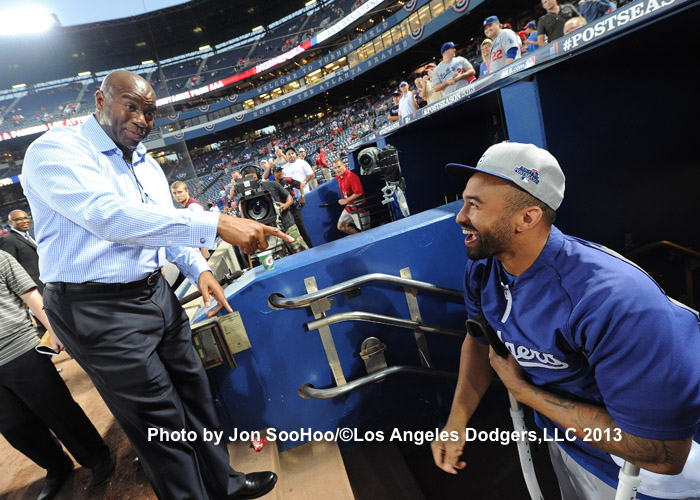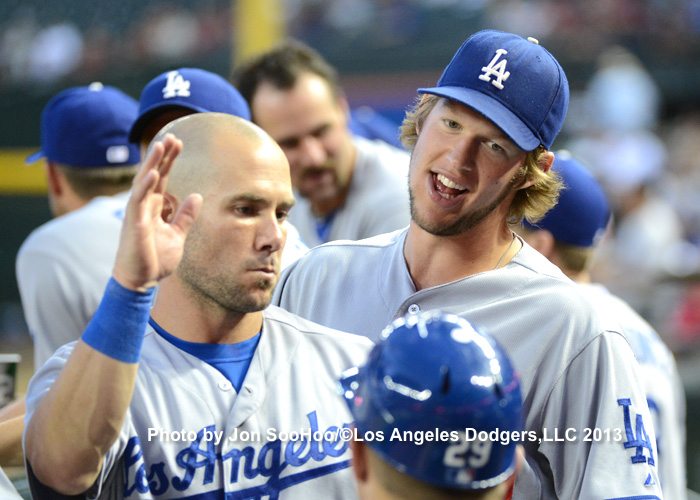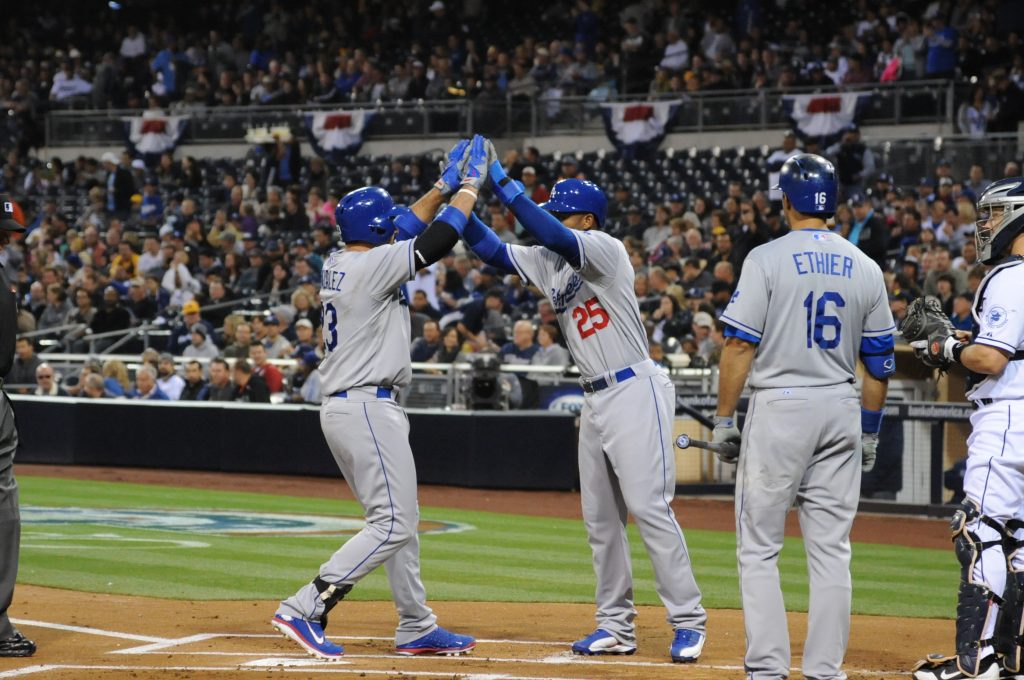
Carl Crawford congratulates Adrian Gonzalez at home plate in San Diego on April 11. (Jon SooHoo/LA Dodgers, LLC 2013)
By Jon Weisman
You don’t even need to look at the numbers, do you? The Dodgers, even as they went all the way to the National League Championship Series in 2013, didn’t hit enough with men on base, right?
Well, maybe we should look at the numbers anyway. Because they’re kind of interesting.
Dodgers with men on base, 2013
(ordered by plate appearances)
Collectively, the Dodgers had a .325 on-base percentage with men on base, nearly identical to their overall 2013 OBP of .326. And of the nine players who came up the most in those situations, none had a lower OBP than .320.
Key RBI guys like Adrian Gonzalez (.362), Andre Ethier (.357) and, holy cow, Hanley Ramirez (.416) kept coming through time and again, either driving in runs or extending innings. Matt Kemp, by contrast, was disappointing at .303, but we’re going to talk more about him in a minute.
Where the Dodgers showed more of a dip was in their slugging percentage – .383 with runners on base, compared to .396 overall in the season. The difference was more pronounced with runners in scoring position.
Dodgers with RISP
(ordered by plate appearances)
If the Dodgers were swinging for the fences with runners in scoring position, the stats show they weren’t connecting. Their slugging percentage dipped 7 percent compared with their overall 2013 performance. On the other hand, their OBP inched up, with the eight guys most frequently batting with RISP doing their part to drive in runs or at least extend innings. And again, Hanley – wow.
In general, given the sample sizes at play and the variables in terms of situation, I’m not sure how significant these differences are. You’d expect pitchers to be more vulnerable with runners on base, if only because vulnerable pitchers tend to put more runners on base. But pitchers being more careful with runners on could also play a role.
Which leads me to latest favorite stat: In 2013, Clayton Kershaw allowed five extra-base hits with runners in scoring position all year.
Keep all this in mind as I present the Dodgers’ performance with the bases loaded in 2013. The sample size shrinks … and the offense shrinks even more.
Dodgers with bases loaded, 2013
(ordered by plate appearances)
Those numbers … well, they are numbers. I’ll give them that. The Dodgers were last in the NL in batting with the bases loaded, by a wide margin. Coming in at 15th was Pittsburgh, with a .591 OPS.
How wildly inconsistent are they from hitter to hitter? No one on that list has a batting average between .200 and .300.
Also, do you see who isn’t on the list? Our friend Mr. Ramirez, whose total number of plate appearances with the bases loaded in 2013 was … one. (He got out.)
Once more, I’d offer that the quantity of plate appearances is too small to derive too much into the Dodgers’ bases-loaded performance, but we can say this: If you’re looking for a way the Dodgers can improve in 2014, look no farther.
I promised to circle back to Matt Kemp, and circle back we shall. Kemp, as you might have noticed, struggled in all of these situations, yet another reason his 2013 was so frustrating. But is it possible that we’ve got this backward – that his frustrations were the reason he struggled with men on base?
Look at how Kemp did in previous seasons:
Matt Kemp with men on base
| I |
Year |
PA |
HR |
BA |
OBP |
SLG |
OPS |
|
2006 |
85 |
4 |
.295 |
.318 |
.513 |
.830 |
|
2007 |
144 |
4 |
.373 |
.396 |
.560 |
.956 |
|
2008 |
296 |
6 |
.282 |
.342 |
.417 |
.760 |
|
2009 |
321 |
13 |
.279 |
.336 |
.463 |
.800 |
|
2010 |
324 |
15 |
.238 |
.299 |
.462 |
.761 |
|
2011 |
347 |
21 |
.344 |
.424 |
.626 |
1.049 |
|
2012 |
204 |
14 |
.331 |
.412 |
.651 |
1.063 |
|
2013 |
145 |
2 |
.246 |
.303 |
.346 |
.650 |
|
Career Total |
1866 |
79 |
.295 |
.357 |
.505 |
.862 |
Matt Kemp with RISP
| I |
Year |
PA |
HR |
BA |
OBP |
SLG |
OPS |
|
2006 |
50 |
3 |
.273 |
.300 |
.523 |
.823 |
|
2007 |
85 |
2 |
.333 |
.353 |
.500 |
.853 |
|
2008 |
168 |
3 |
.268 |
.359 |
.394 |
.754 |
|
2009 |
190 |
9 |
.279 |
.342 |
.485 |
.827 |
|
2010 |
193 |
8 |
.225 |
.311 |
.456 |
.767 |
|
2011 |
200 |
13 |
.335 |
.450 |
.652 |
1.102 |
|
2012 |
107 |
5 |
.292 |
.383 |
.551 |
.934 |
|
2013 |
87 |
0 |
.230 |
.310 |
.270 |
.581 |
|
Career Total |
1080 |
43 |
.279 |
.360 |
.486 |
.846 |
Matt Kemp with bases loaded
| I |
Year |
PA |
HR |
BA |
OBP |
SLG |
OPS |
|
2006 |
7 |
0 |
.167 |
.143 |
.167 |
.310 |
|
2007 |
10 |
0 |
.000 |
.100 |
.000 |
.100 |
|
2008 |
18 |
1 |
.250 |
.222 |
.500 |
.722 |
|
2009 |
19 |
3 |
.313 |
.316 |
.938 |
1.253 |
|
2010 |
15 |
1 |
.300 |
.333 |
.600 |
.933 |
|
2011 |
10 |
1 |
.571 |
.500 |
1.000 |
1.500 |
|
2012 |
9 |
0 |
.250 |
.222 |
.250 |
.472 |
|
2013 |
9 |
0 |
.125 |
.111 |
.125 |
.236 |
|
Career Total |
97 |
6 |
.250 |
.258 |
.500 |
.758 |
Historically, Kemp has been good to great with runners on base, before falling off a cliff in 2013. (Weird stat No. 2: Kemp had more grand slams in 2009 than hits with the bases loaded in 2013). A healthier Kemp obviously makes the Dodgers a better team; this is but one example of the difference he might make.
The big question I have is how much control players really have over their performance with runners on base. In a conversation for the season preview story of the upcoming Dodgers’ March magazine (which you all are going to want to get), Dodger manager Don Mattingly shared his thoughts.
“You put an emphasis on it in Spring Training,” Mattingly said. “You continue to put guys in situations in camp and work on things. … Everyone tries to drive that run in, and a lot of times they do it really fast. Sometimes it’s just being willing to let the next guy do it, because they may not be willing to pitch to (you). So if they’re not going to give you anything to do it with … you’ve got to be willing to pass the baton and trust your teammate.”
Easier said than done? No doubt. But even though their performance with runners on base might be better than you realized — and certainly improved when they heated up in the summer — it remains something the Dodgers will think about.


